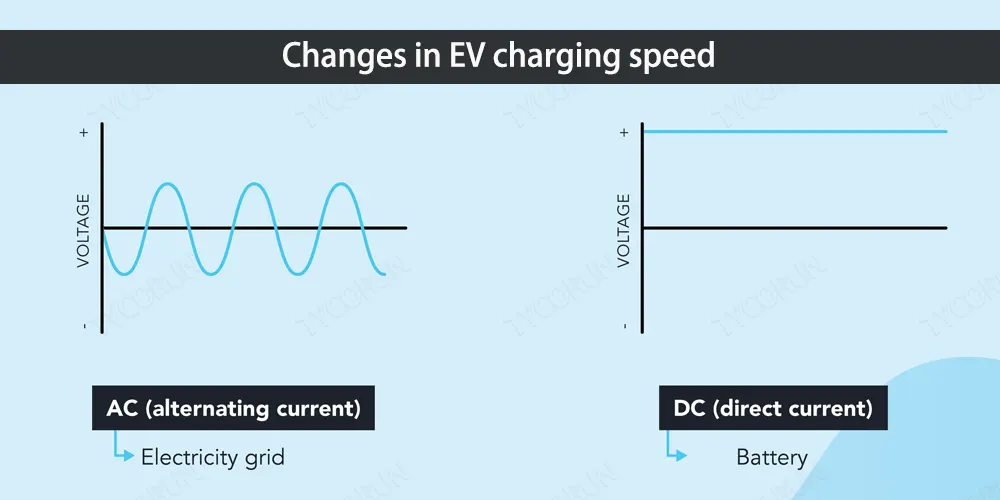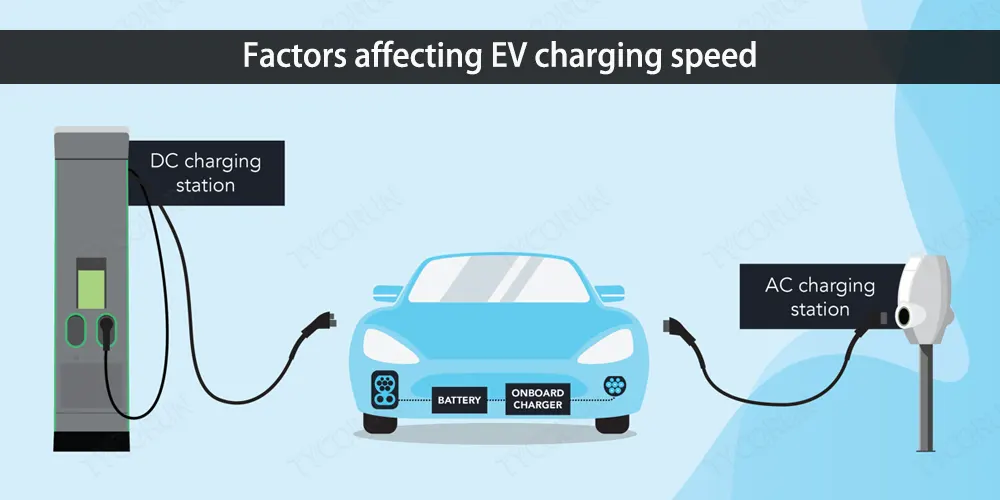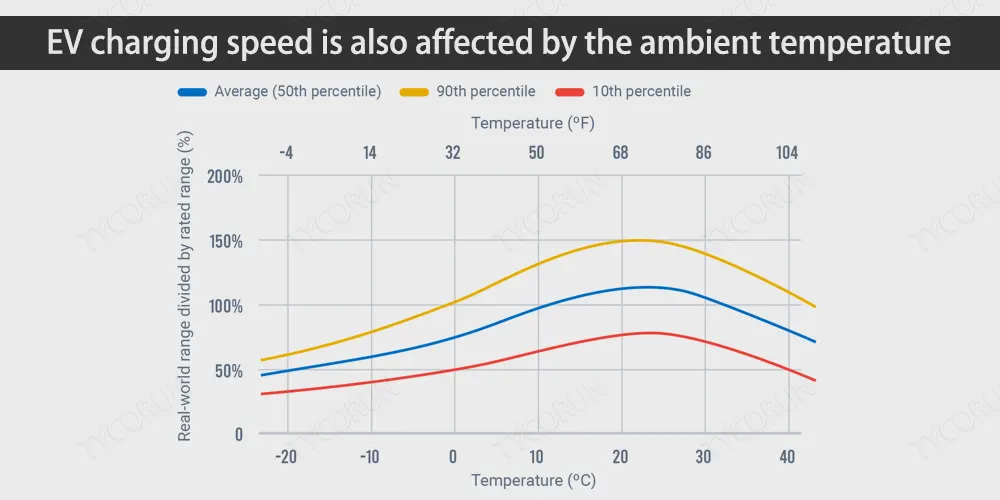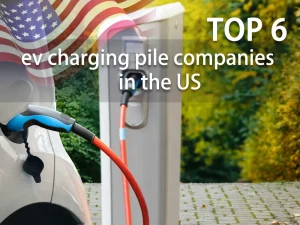Home » lithium ion battery knowledge » 8 factors affecting EV charging speed
8 factors affecting EV charging speed

EV battery charging process
When it comes to charging, it is usually divided into “fast” and “slow”. The fast charging time of different vehicles is slightly different. For details, please refer to the data released by the manufacturer. The charging process is not a simple physical connection between the battery charger and the jack. As for fast charging, the charging process can generally be divided into five steps:
- Physical connection: connect the charger and the jack;
- Low-voltage auxiliary power supply: the charging pile provides low-voltage auxiliary DC power to the electric vehicle to activate the BMS (battery management system);
- Charging handshake: the car end and the pile end send “handshake” information to each other to obtain the parameters related to charging;
- Charging parameter configuration: the basic parameters of the charging pile end and the car end are matched, including the maximum charging power required by the car end, the maximum output power of the charging pile, etc., to ensure that both sides “fit” during the subsequent charging process;
- Charging: The built-in BMS of the electric vehicle will send charging power demand information to the charging pile, and the charging pile will adjust its own output voltage and current in real time according to the information to ensure the smooth charging process. At the same time, they will monitor the charging status of each other in real time to ensure safe charging.
From the charging process, it is not difficult to find that the process of EV fast charging is actually a process of real-time interaction between the BMS and the charging pile information, and the process of controlling the output voltage and current of the charging pile.
Changes in EV charging speed
If we carefully observe the charging process of the power battery, we will find that the charging speed of the battery is not linear, and the EV charging speed is different under different remaining power values. The EV charging speed can be roughly divided into three periods, the first 20% is the fastest, the middle 20%-80% is faster, and the last 20% is slower.
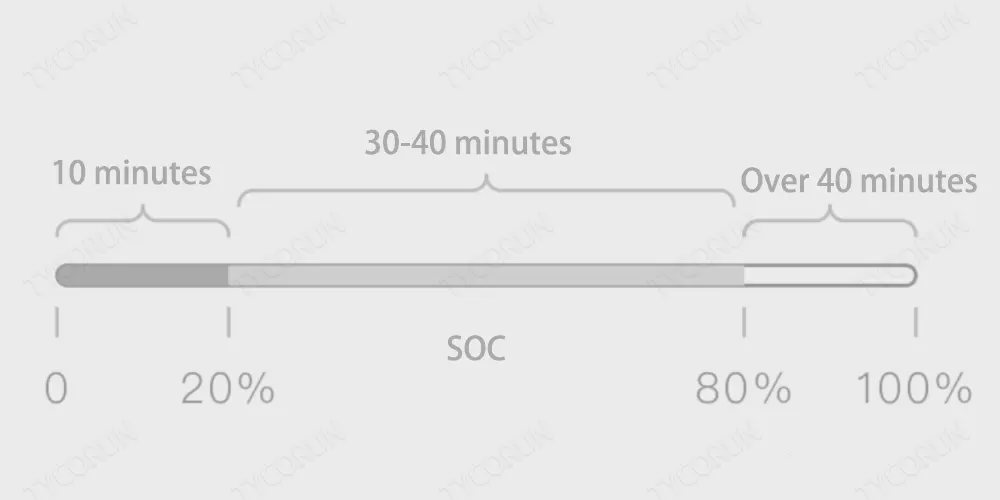
About 10 minutes after starting charging, the battery is in the warm-up stage, and the battery activity is gradually increasing. In this state, the charging power required by the battery is gradually increasing, and the EV charging speed is also accelerating. When the SOC reaches 50%~60% (the situation of different brands of models is slightly different), the power demand begins to decline, and the EV charging speed naturally slows down.
From the perspective of the entire charging process, the charging power required by the power battery is different at different stages. Generally speaking, when the SOC is between 20% – 80%, the EV charging speed will be faster, and the overall trend is from fast to slow.
When the SOC reaches 95%, the battery is close to full. In order to protect the safe charging of the battery during the working process, the BMS system will intervene at this time, and the charging pile will charge at a lower charging power to protect the health of the EV battery to make sure charging is safe. However, the above-mentioned problems cause some EV owners to drive away without waiting for a full charge, resulting in a decline in the full-load usage of the battery and then degradation.
Factors affecting EV charging speed
In addition to the BMS control strategy mentioned above, the EV charging speed is also related to 8 factors, including the power, battery capacity, battery aging, current power, environment temperature, battery temperature battery type, and other features loaded. Let’s take a look one by one:
Power
Generally speaking, the greater the output power of the charging pile, the shorter the charging time. Charging is the process in which the charging pile responds to the charging power of the electric vehicle. When the vehicle terminal voltage platform is higher than the charging pile voltage platform, the charging pile will not be able to charge the electric vehicle.
Also, when the maximum output power of the charging pile is lower than the charging power required by the electric vehicle, the electric vehicle cannot achieve the expected EV charging speed. The input power that different cars can accept is different, and some EV battery power is determined by the car model, which will make users of the same charging station feel differently.
To maximize EV charging speed, users should choose a charging station that is compatible with the electric vehicle’s current and voltage limits. For example, if the maximum charging power of an electric vehicle is 50 kW, the user should choose a charging station that can provide at least 50 kW of charging power. Likewise, if the electric vehicle has a greater charging power, such as 150 kW or 350 kW, the user will need to choose a charging station that can provide this level of charging power.
Battery capacity
In the case of the same fixed power output at the charging pile end, the larger the power battery of the vehicle, the longer the charging time. This is like filling a pool with water through a drain pipe of the same caliber. The larger the pool, the longer it takes to fill it with water.
Battery aging
The aging of the battery leads to a decrease in capacity, so even if the user drive the same car to the same charging station to recharge, he/she will feel that the speed is not as good as before. Maintaining the state of health of EV battery is critical to optimizing EV charging speed. It includes avoiding prolonged discharge, which can accelerate battery degradation.
It’s also important to follow the EV manufacturer’s battery care guidelines and avoid exposing the EV to extreme temperatures, as both heat and cold can accelerate battery degradation.
Current power
Custom lithium battery manufacturers will consider the actual needs of users when producing batteries, so they design the charging time for the situation when the battery is low. The amount of power is inversely proportional to the charging rate, which means that the lower the power, the shorter the charging time.
When charging, the first thing to look at is the power level of the car. The higher the charge level, the slower the EV charging speed.
For example, when an electric vehicle is charged at 80%, the EV charging speed may be 20kWh; but when the battery is at 50%, it can provide a EV charging speed of 50kWh; when the battery is close to 100%, its charging speed will be quickly lowered. The main reason for this is that the car needs to protect its battery from charging too fast and damaging the battery.
Environment temperature
The rate at which the battery discharges is also affected by the ambient temperature. For example, charging a car in winter will obviously take longer than in summer. Especially in cold regions, it is difficult to charge the EV in winter, or the EV charging speed can be very slow.
This is related to the chemical characteristics of the battery itself, which is called low temperature protection. When the temperature is too low, the lithium metal in the battery will deposit and there will be no more chemical reactions with substances, resulting in an internal short circuit of the battery.
Battery temperature
The colder the battery, the less chemically active the lithium ion battery will be, making it slower to charge and harder to fully charge. Generally, the best discharge temperature for EV battery is about 25℃.
The best rechargeable battery temperature is between 10℃ – 30℃. If the battery temperature is lower than 10℃, the battery itself will absorb part of the power and affect the EV charging speed. If it is higher than 30℃, the charging speed will be automatically reduced, because the car will automatically protect its battery from potential danger.
For this purpose, electric vehicles can be parked under the shade of trees or in underground parking garages. If the car is in a cold environment, it is recommended to start the car for a while before charging.
Battery type
The type of EV battery is also one of the factors that affect EV charging speed. Currently, there are three main battery types: lead-acid, nickel metal hydride, and lithium ion. Lead-acid batteries are the most popular and the cheapest, but the charging time is longer, which takes 6-8 hours to charge. The charging time of Ni-MH batteries is shorter, generally between 3-5 hours, but the energy density is lower.
When compare li-ion vs ni-mh battery, li ion batteries have become the main battery type for the new generation of electric vehicles. The charging time can be adjusted by the charging power and the protection measures of the EV battery itself and the general charging time is 2-4 hours.
Other features loaded
When the car is charging, if other power-consuming functions of the car (such as air conditioning, panoramic lights, etc.) are also used at the same time, the charging speed will be affected.
For the best EV charging speed, it is recommended to keep the electric vehicle silent. Air conditioners and other electronic products in the car should be used to a minimum if they must use the car’s electricity. The advantage of it is not only to allow electric vehicles to obtain the best EV charging speed, but also to avoid overloading the car’s power.



